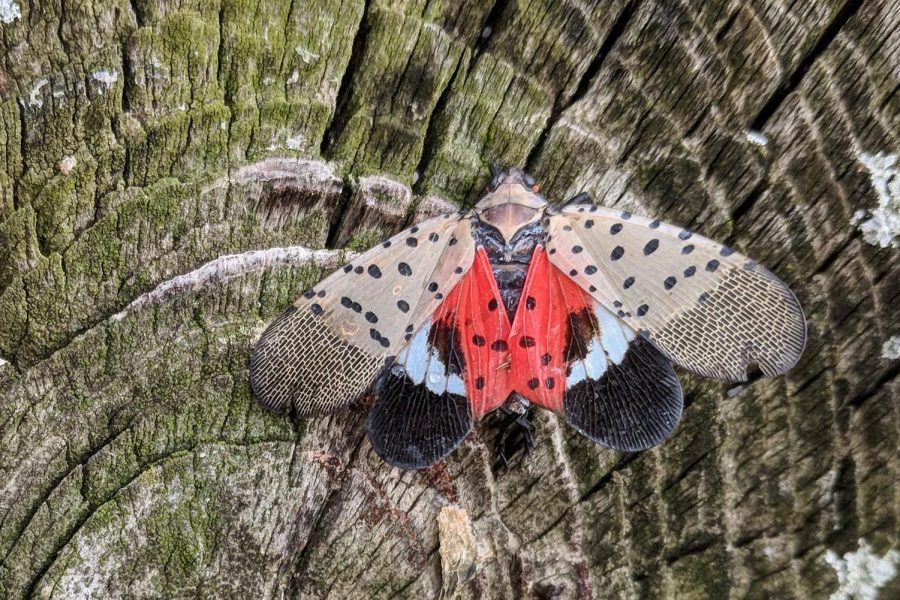The Spotted Lanternfly Population Continues to Wreak Havoc in New York
Fordham professors and students raise concerns towards the lack of knowledge about the invasive species
CHESAPEAKE BAY PROGRAM VIA FLICKR
If you see this insect, know that it is invasive and dangerous to many plants and to the agriculture of the New York metro area.
October 25, 2021
Indigenous to Asia, the spotted lanternfly has spread across 11 states in America, including New York. This invasive species could potentially wreak havoc on multiple U.S. industries such as agriculture and timber.
The migration of the lanternflies can be linked to the invasive species “ailanthus,” better known as the tree of heaven.
Ailanthus is itself an invasive species brought in from south or east Asia in the 18th century. It is now considered a “weed tree without significant commercial value,” Robert Madden, a Fordham professor of biology, said. “Over the centuries, it has become widely established in the U.S.”
“The biggest concern seems to be its impact on trees of agricultural value, including grapes and other fruit trees.” Robert Madden, Fordham biology professor
As the primary host species for lanternfly populations, the ailanthus is almost essential for the lanternflies to reproduce. According to the U.S. Department of Agriculture, the lanternfly species was introduced to the United States through shipments of imported wood from China in 2014. It is also encouraged to kill these insects on sight by numerous government officials because if they continue to grow, their existence is predicted to devastate multiple crop populations and economies.
The lanternfly is roughly an inch long with deep black spots freckled over its light brown front wings. In contrast, its hind wings are red with splotches of black, while its abdomen is a vivid yellow.
Although tiny, the invasive species is raising concerns about its agricultural impact across the nation.
“The biggest concern seems to be its impact on trees of agricultural value, including grapes and other fruit trees,” Madden said. “It also attacks a variety of forest trees, including maples, birches and black walnuts.”
Lanternflies feed directly on the sap of plants, leading to dead branches, wilting and a steady health decline.
With few natural predators in the United States, the lanternfly population could continue to grow if left unchecked. A high population of lanternflies could possibly cause critical damage to forestry and agricultural crops.
They have already been recorded eating the plant sap of over 70 different types of plants, all of which are vital to the American ecosystem. Lanternflies feed directly on the sap of plants, leading to dead branches, wilting and a steady health decline. They also excrete a liquid that is a prime medium for many types of sooty molds and fungi to form and kill ground cover plants by blocking out sunlight.
“The extent of its impact on forest trees is a bit less clear at this point,” Madden said. “It appears to weaken trees but is not likely to kill an otherwise healthy tree. I would guess that this might cause lumber production to be reduced.”
Madden highlighted that biological control, a method of using other species to control an invasive species, can be wielded to efficiently control the lanternfly population.
“There has been more emphasis on trying to use biological control. For an invasive species, this can involve finding a predator or disease that controls it in its native habitat,” Madden said. “Some fungi have been discovered that kill lanternflies. Also, control of ailanthus is useful since it seems to be needed for a sustained population.”
Although this is a growing issue, many Fordham students reported being unaware of the spotted lanternfly and its accompanying problems. Maya Dawson, Fordham College at Lincoln Center (FCLC) ’25, claimed she had not heard about the growth of the spotted lanternfly population in New York.
“Before this conversation, I hadn’t heard of lanternflies, but it seems to be a prevalent issue that we should know more about especially because of how harmful its long term effects are on our ecosystems,” Dawson said.
“It is important that students are aware to kill them immediately.” Omi Mehta, FCLC ’25
Other students who are aware of this issue believe that students must be educated on how much of an impact this invasive species is having on our ecosystems. Omi Mehta and Belen Gonzalez, both FCLC ’25, proposed the idea that Fordham should spread more awareness about the growth of the lanternfly population in NYC.
“I’ve seen rows of them right outside my mom’s office and the effects of them are disastrous. It is important that students are aware to kill them immediately,” Mehta said.
Gonzalez added: “They’re just not a part of our ecosystems. They simply don’t belong here. Spreading poster flyers could potentially help slow down their reproduction.”
Unlike most insects that need specific conditions to lay eggs — conditions such as dirt, grass or plants — lanternflies can lay their eggs anywhere. From plain concrete to car wheels, lanternfly eggs have been spotted anywhere that gives them a hefty advantage to survive. The lanternfly population continues to grow in Pennsylvania, New Jersey and New York.













